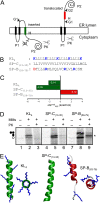The surfactant peptide KL4 sequence is inserted with a transmembrane orientation into the endoplasmic reticulum membrane
- PMID: 18621816
- PMCID: PMC2527282
- DOI: 10.1529/biophysj.108.138602
The surfactant peptide KL4 sequence is inserted with a transmembrane orientation into the endoplasmic reticulum membrane
Abstract
Surfactant protein B (SP-B) is an essential component of pulmonary surfactant. Synthetic surfactant peptide KL(4), a peptide based on a C-terminal amphipathic helical region of human SP-B, efficiently mimics some functional properties of SP-B and is included in therapeutic surfactant preparations used in trials to treat respiratory distress syndrome. The membrane orientation of this peptide is controversial. We used an in vitro transcription-translation system to study the insertion of hydrophobic sequences into microsomal membranes, and showed that the KL(4) sequence integrates efficiently with a transmembrane orientation despite the presence of intermittent lysines throughout the sequence. In contrast, the precise sequence of the C-terminal SP-B amphipathic region failed to integrate, indicating a nontransmembrane orientation. Differences in the membrane insertion between KL(4) and the SP-B-inspiring sequence match predictions from calculated free energies of insertion of the two sequences into membranes.
Figures

Similar articles
-
Synthetic peptide-containing surfactants--evaluation of transmembrane versus amphipathic helices and surfactant protein C poly-valyl to poly-leucyl substitution.Eur J Biochem. 1998 Jul 1;255(1):116-24. doi: 10.1046/j.1432-1327.1998.2550116.x. Eur J Biochem. 1998. PMID: 9692909
-
KL₄ peptide induces reversible collapse structures on multiple length scales in model lung surfactant.Biophys J. 2011 Dec 21;101(12):2957-65. doi: 10.1016/j.bpj.2011.10.050. Epub 2011 Dec 20. Biophys J. 2011. PMID: 22208194 Free PMC article.
-
From Pulmonary Surfactant, Synthetic KL4 Peptide as Effective siRNA Delivery Vector for Pulmonary Delivery.Mol Pharm. 2017 Dec 4;14(12):4606-4617. doi: 10.1021/acs.molpharmaceut.7b00725. Epub 2017 Nov 17. Mol Pharm. 2017. PMID: 29121767
-
Synthetic surfactants with SP-B and SP-C analogues to enable worldwide treatment of neonatal respiratory distress syndrome and other lung diseases.J Intern Med. 2019 Feb;285(2):165-186. doi: 10.1111/joim.12845. Epub 2018 Nov 14. J Intern Med. 2019. PMID: 30357986 Review.
-
Surfactant protein B and C analogues.Mol Genet Metab. 2000 Sep-Oct;71(1-2):342-51. doi: 10.1006/mgme.2000.3053. Mol Genet Metab. 2000. PMID: 11001826 Review.
Cited by
-
Membrane insertion and biogenesis of the Turnip crinkle virus p9 movement protein.J Virol. 2010 Jun;84(11):5520-7. doi: 10.1128/JVI.00125-10. Epub 2010 Mar 24. J Virol. 2010. PMID: 20335263 Free PMC article.
-
Human Peroxin PEX3 Is Co-translationally Integrated into the ER and Exits the ER in Budding Vesicles.Traffic. 2016 Feb;17(2):117-30. doi: 10.1111/tra.12350. Epub 2015 Dec 21. Traffic. 2016. PMID: 26572236 Free PMC article.
-
Insertion of Bacteriorhodopsin Helix C Variants into Biological Membranes.ACS Omega. 2019 Dec 31;5(1):556-560. doi: 10.1021/acsomega.9b03126. eCollection 2020 Jan 14. ACS Omega. 2019. PMID: 31956802 Free PMC article.
-
Partitioning, dynamics, and orientation of lung surfactant peptide KL(4) in phospholipid bilayers.Biochim Biophys Acta. 2010 Feb;1798(2):216-22. doi: 10.1016/j.bbamem.2009.08.020. Epub 2009 Sep 6. Biochim Biophys Acta. 2010. PMID: 19735643 Free PMC article.
-
The C-terminal Domains of Apoptotic BH3-only Proteins Mediate Their Insertion into Distinct Biological Membranes.J Biol Chem. 2016 Nov 25;291(48):25207-25216. doi: 10.1074/jbc.M116.733634. Epub 2016 Oct 7. J Biol Chem. 2016. PMID: 27758854 Free PMC article.
References
-
- Johansson, J., and T. Curstedt. 1997. Molecular structures and interactions of pulmonary surfactant components. Eur. J. Biochem. 244:675–693. - PubMed
-
- Serrano, A. G., and J. Perez-Gil. 2006. Protein-lipid interactions and surface activity in the pulmonary surfactant system. Chem. Phys. Lipids. 141:105–118. - PubMed
-
- Perez-Gil, J., C. Casals, and D. Marsh. 1995. Interactions of hydrophobic lung surfactant proteins SP-B and SP-C with dipalmitoylphosphatidylcholine and dipalmitoylphosphatidylglycerol bilayers studied by electron spin resonance spectroscopy. Biochemistry. 34:3964–3971. - PubMed
-
- Robertson, B., and H. L. Halliday. 1998. Principles of surfactant replacement. Biochim. Biophys. Acta. 1408:346–361. - PubMed
-
- Mingarro, I., D. Lukovic, M. Vilar, and J. Perez-Gil. 2008. Synthetic pulmonary surfactant preparations: new developments and future trends. Curr. Med. Chem. 15:393–403. - PubMed
Publication types
MeSH terms
Substances
LinkOut - more resources
Full Text Sources

